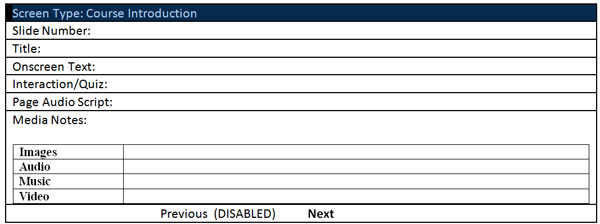It’s an inside joke in the eLearning world. Getting content from your subject matter experts (SMEs) can be a bit of a nightmare. You ask the SME for information about the jigglyzazoo and she sends either 1) a PowerPoint presentation with minimal useful information or 2) a mountain of documents (which she now expects you to use, since she’s taken the time to find them!).
This situation is a common one and it’s a problem that has an obvious solution: Be much more specific about exactly what you need. It may take a little back and forth to help your SME get you what you’re asking for, but in the long run this will reduce time and effort on both your parts and get you better content, faster.
Getting specific
Here’s an example from real life. I’m just starting to work with a client and we’re building a series of modules that have to do with construction issues. We’re considering using a story approach. The design approach we’re thinking of using will require a lot of real-life pictures and the client is the SME and a photographer. Rather than tell her to go take a bunch of pictures (many of which might be completely unusable), I’m providing her with a list of very specific images needed. The list looks something like the list in Table 1.
| Images needed for lesson 6-1 | Notes |
| 1. Close-up of worker inspecting window frame | Worker should be wearing typical work clothing |
| 2. Zoom in from shot 1 showing workers hand and the window frame needing caulking |
|
The main idea here is to give SMEs more direction in the content that you want them to provide so that both you and the SME are less frustrated. (You may need to coach them a few times so be prepared for some conversations, examples, and hand holding at first.)
Text content templates
Since textual content is one of the most common items we want SMEs to provide, I’ll start by discussing ways to focus SMEs efforts on the exact text content we want.
There are two common ways that we ask SMEs for content and both have typical flaws. The first way is to just ask for certain content, “Sarah, what do you have on the importance of …” When we just ask for content, we have no clue what we’re going to get. And when we don’t get what we want (which is typical), we’re frustrated and so is the SME. Bad idea.
Another way that we typically ask for text content from SMEs is to give them a storyboard and ask them to fill in their sections. For example, Figure 1 shows a course introduction screen from a typical storyboard.

Figure 1. Section from a typical storyboard
Let me list a number of potential problems with giving SMEs storyboards like this. They may:
- Have no clue how a storyboard works
- Not know what the terms mean
- Not understand what information they should type in
- Not know how much information is needed
- And so on…
Even if you provide an example, storyboards can be daunting to folks who don’t regularly work with them. So here’s a better idea.
Provide mocked up screens in PowerPoint or Word (tools they are probably familiar with) in which the SME inputs the text (see Figure 2 for an example).

Figure 2. Mocked up screen for SME to input text
Mocked up screens provide visual context and allow you to explain to the SME what you want. In addition, if you set them up properly, they can show your SME how much space is available so they don’t provide too much text! To provide additional context, give them all the mockups in order so your SME gets the picture of how the instruction flows.
Use actual page templates
Better yet, train your SME to work in the actual page templates and edit the content from there so you don’t need to create mockups and do the work to edit and transfer that content. Many eLearning designers and developers will say that it’s impossible to train SMEs to use the same tools that we use but I think that’s a ridiculous notion. Rapid development tools were made for SMEs to use. Many of us use PowerPoint as our initial development tool and many SMEs can use PowerPoint. And let’s face it, many trainers and instructional designers were once SMEs. So who are we kidding? We CAN train SMEs to do some content development in our tools (assuming they are willing).
This is only the beginning
I’ll take this a bit further next month, but I hope I’ve given you some initial food for thought on how to get your SMEs focused on giving you what you need when you ask for content. If you have additional ideas, feel free to add them to the comments section.



